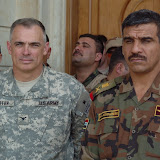“Torch” Lighting the Way for Mansour Security
Digital Video and Imagery Distribution System
By 1st Lt. Charles Bloomfield; 2nd Battalion, 32nd Field Artillery Regiment
April 30, 2007
BAGHDAD — Construction of Joint Security Station “Torch” was completed and it was officially opened April 21, in the Mansour district of the capital city.
Planning and securing such a location does not come quickly or without proper preparation. In March, members of the Neighborhood Advisory Council (NAC) and the Iraqi army began nominating locations for the station.
Iraqi army troops and Soldiers from 2nd Battalion, 32nd Field Artillery Regiment, 2nd Brigade Combat Team, 1st Infantry Division, conducted a recon of the area April 12, and plans for construction began in earnest. A concept brief took place the following day and a final synchronization meeting with all the elements involved from the 2nd “Dagger” Brigade ensued a couple days later.
Plans were made for barrier emplacement, concertina wire, sandbags, overwatch positions, checkpoints, waste removal, and many other logistical details. Pieces began to fall into place for building, securing and making the site habitable.
The construction operations began as scheduled, but that was not the only mission Soldiers from the 2nd “Proud Americans” Battalion, 32nd FA, had in mind.
JSS Torch is located on the corner of a city block and would definitely have an impact on the local residents of the community. On the first day of construction, the ‘Good Neighbor Plan’ went into effect and Capt. Jose Henderson, Capt. Brian McCall, and Capt. Jayson Morgan visited each of the houses surrounding the newly-acquired property.
They introduced themselves and offered a gift, including candy, a picture of the battalion commander, Lt. Col. Gregory Gadson, Col. Ali, the 2nd Battalion, 5th Brigade, 6th Iraqi Army commander, and Lt. Col. Rahim, the 3rd Battalion, 5th Brigade, 6th Iraqi Army commander. They also hand-delivered a letter to introduce and explain the current project.
Soldiers placed the first barrier of JSS Torch into place on the morning of April 16. Soldiers throughout the Proud American Battalion, as well as those from 9th Engineer, 20th Engineer, and 299th Forward Support battalions, worked tirelessly day and night to complete the project on time, keep it secure, and to get it fully operational.
Construction was completed on April 19.
JSS Torch officially opened for business the morning of April 21. Iraqi security force liaisons occupied the building that morning and the JSS became a center for combined forces.
Later in the day, Maj. Gen. Abdul Al-Ameer, commander of the 6th Iraqi Army Division, arrived for a brief on the JSS, a tour, an awards ceremony and a traditional Iraqi lunch. After the awards ceremony, Ameer addressed everyone and specifically reminded the Soldiers of their duties.
“Be good to the citizens and they will trust you,” he said. “Remember that your loyalty is to Iraq; not for the party, not for the tribe, not for sect or religion. The party will go away; the tribe will go away; the religion might go away, but Iraq will stay.”
Gadson echoed the Iraqi Army general’s remarks, and told the Iraqi and U.S. troops assembled why he had chosen the name “Torch” for the JSS. He said it not only honored the Proud American’s combat experience in 1942, but this JSS and Iraqi Army represent “the light in the future of the Mansour district.”
With the formalities over, the first southeast Mansour security meeting, representing the real work of the JSS, occurred the next day. The meeting outlined ideas to conduct coordinated combined operations with Iraqi security forces and coalition forces.
Future goals include building a common operating picture for the combined forces to work with and to secure support for the civil authorities. Through this way ahead, Iraqi security forces will eventually take control of security and the civil leaders will be empowered to improve the living conditions within their neighborhoods.






